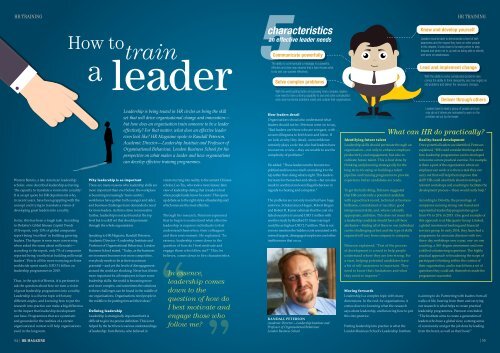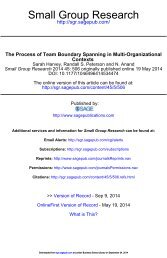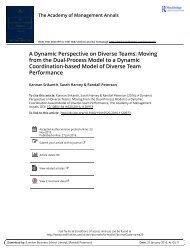How to train a leader
Published in HR Magazine
Published in HR Magazine
- TAGS
- organisation
- leadership
You also want an ePaper? Increase the reach of your titles
YUMPU automatically turns print PDFs into web optimized ePapers that Google loves.
HR TRAINING<br />
HR TRAINING<br />
characteristics<br />
an effective <strong>leader</strong> needs<br />
Communicate powerfully<br />
The ability <strong>to</strong> communicate a message in a powerful,<br />
effective and clear way ensures that a team knows what<br />
<strong>to</strong> do and can operate effectively.<br />
Solve complex problems<br />
With the world getting faster and growing more complex, <strong>leader</strong>s<br />
now need <strong>to</strong> have a strong capability <strong>to</strong> see and solve complicated<br />
and cross-functional problems inside and outside their organisations.<br />
Know and develop yourself<br />
Leaders must be able <strong>to</strong> demonstrate a level of selfawareness<br />
and the impact they have on other people.<br />
In this respect, it boils down <strong>to</strong> knowing when <strong>to</strong> step<br />
forward and when not <strong>to</strong>, as well as being able <strong>to</strong> identify<br />
and work on weaknesses.<br />
Lead and implement change<br />
With the ability <strong>to</strong> solve complicated problems also<br />
comes the ability <strong>to</strong> think divergently, see new angles on<br />
old problems and deliver the necessary changes.<br />
Deliver through others<br />
Warren Bennis, a late American <strong>leader</strong>ship<br />
scholar, once described <strong>leader</strong>ship as having<br />
‘the capacity <strong>to</strong> translate a vision in<strong>to</strong> a reality’.<br />
It is an apt quote for HR departments who,<br />
in recent years, have been grappling with the<br />
concept and trying <strong>to</strong> translate a vision of<br />
developing great <strong>leader</strong>s in<strong>to</strong> a reality.<br />
So far, this has been a <strong>to</strong>ugh task. According<br />
<strong>to</strong> Deloitte’s Global Human Capital Trends<br />
2016 report, only 13% of global companies<br />
report being ‘excellent’ in building growing<br />
<strong>leader</strong>s. The figure is even more concerning<br />
when asked the same about millennials—<br />
according <strong>to</strong> the report, only 7% of companies<br />
reported being ‘excellent at building millennial<br />
<strong>leader</strong>s’. This is all the more worrying as firms<br />
worldwide spent nearly USD 31 billion on<br />
<strong>leader</strong>ship programmes in 2015.<br />
Thus, in the spirit of Bennis, it is pertinent <strong>to</strong><br />
ask the question about how we turn a vision<br />
of great <strong>leader</strong>ship programmes in<strong>to</strong> a reality.<br />
Leadership is a diverse <strong>to</strong>pic with many<br />
different angles, and knowing how <strong>to</strong> put the<br />
research in<strong>to</strong> practice can make a big difference<br />
<strong>to</strong> the impact that <strong>leader</strong>ship development<br />
can have. Programmes that are systematic<br />
and grounded in the realities of a certain<br />
organisational context will help organisations<br />
excel in the long term.<br />
Leadership is being <strong>to</strong>uted in HR circles as being the skill<br />
set that will drive organisational change and innovation—<br />
but how does an organisation <strong>train</strong> someone <strong>to</strong> be a <strong>leader</strong><br />
effectively? For that matter, what does an effective <strong>leader</strong><br />
even look like? HR Magazine spoke <strong>to</strong> Randall Peterson,<br />
Academic Direc<strong>to</strong>r—Leadership Institute and Professor of<br />
Organisational Behaviour, London Business School for his<br />
perspective on what makes a <strong>leader</strong> and how organisations<br />
can develop effective <strong>train</strong>ing programmes.<br />
Why <strong>leader</strong>ship is so important<br />
There are many reasons why <strong>leader</strong>ship skills are<br />
more important than ever before: the workplace<br />
is becoming increasingly ‘team-centric’,<br />
workforces have gotten both younger and older,<br />
and business challenges have demanded a need<br />
for more <strong>leader</strong>s. As firms strive <strong>to</strong> innovative<br />
further, <strong>leader</strong>ship is not just found at the <strong>to</strong>p<br />
level but is a skill set that should permeate<br />
through the whole organisation.<br />
Speaking <strong>to</strong> HR Magazine, Randall Peterson,<br />
Academic Direc<strong>to</strong>r—Leadership Institute and<br />
Professor of Organisational Behaviour, London<br />
Business School stated, “Today, as the business<br />
environment becomes ever more competitive,<br />
everybody needs <strong>to</strong> be at their maximum<br />
potential—and yet the levels of disengagement<br />
around the world are shocking. Never has it been<br />
more important for all employees <strong>to</strong> have some<br />
<strong>leader</strong>ship skills: the world is becoming more<br />
and more complex, and sometimes the solutions<br />
<strong>to</strong> these challenges can be found in the middle of<br />
our organisations. Organisations need people in<br />
the middle <strong>to</strong> be putting forward their ideas.”<br />
Defining <strong>leader</strong>ship<br />
Leadership is strategically important but it is<br />
difficult <strong>to</strong> give it a precise definition. This is not<br />
helped by the fact there is various understandings<br />
of <strong>leader</strong>ship: from Bennis, who believed in<br />
visions turning in<strong>to</strong> reality, <strong>to</strong> the ancient Chinese<br />
scholar, Lao Tzu, who <strong>to</strong>ok a more laissez-faire<br />
view of <strong>leader</strong>ship stating that ‘a <strong>leader</strong> is best<br />
when people barely know he exists’. This opens<br />
up debate as <strong>to</strong> the right styles of <strong>leader</strong>ship and<br />
which ones are the most effective.<br />
Through his research, Peterson expressed<br />
that <strong>to</strong> begin <strong>to</strong> understand what effective<br />
<strong>leader</strong>ship is requires individuals <strong>to</strong> first<br />
understand themselves, their colleagues<br />
and their environment. He explained, “In<br />
essence, <strong>leader</strong>ship comes down <strong>to</strong> the<br />
question of how do I best motivate and<br />
engage those who follow me?” This, he<br />
believes, comes down <strong>to</strong> five characteristics.<br />
In essence,<br />
<strong>leader</strong>ship comes<br />
down <strong>to</strong> the<br />
question of how do<br />
I best motivate and<br />
engage those who<br />
follow me?<br />
<strong>How</strong> <strong>leader</strong>s derail<br />
Organisations shoud also understand what<br />
<strong>leader</strong>s should not be. Peterson went on <strong>to</strong> say,<br />
“Bad <strong>leader</strong>s are those who are arrogant, with<br />
an unwillingness <strong>to</strong> both learn and listen. If<br />
we look at why they derail, overconfidence<br />
certainly plays a role but also bad <strong>leader</strong>s have<br />
<strong>to</strong>o narrow a view—they are unable <strong>to</strong> see the<br />
complexity of problems.”<br />
He added, “These <strong>leader</strong>s tend <strong>to</strong> become <strong>to</strong>o<br />
political and focus <strong>to</strong>o much on making it <strong>to</strong> the<br />
<strong>to</strong>p rather than doing what is right. This leads <strong>to</strong><br />
burnouts for themselves and others—but can also<br />
result in unethical and even illegal behaviour in<br />
regards <strong>to</strong> cheating and corruption.”<br />
The problems are not only moral but have huge<br />
costs <strong>to</strong>o. Scholars Joyce Hogan, Robert Hogan<br />
and Robert B. Kaiser estimate that the cost of a<br />
failed executive is around USD 1 million with<br />
another study by Bradford D. Smart saying it<br />
could be as high as USD 2.7 million. This is not<br />
even <strong>to</strong> mention the hidden costs associated with<br />
missed targets, disengaged employees and other<br />
inefficiencies that occur.<br />
RANDALL PETERSON<br />
Academic Direc<strong>to</strong>r—Leadership Institute and<br />
Professor of Organisational Behaviour<br />
London Business School<br />
Identifying future talent<br />
Leadership skills should permeate through an<br />
organisation—not only <strong>to</strong> enhance employee<br />
productivity and engagement, but also <strong>to</strong><br />
cultivate future talent. This is best done by<br />
thinking and planning strategically for the<br />
long term; focusing on building a talent<br />
pipeline and <strong>train</strong>ing programme <strong>to</strong> provide<br />
experience before candidates are ready.<br />
To get the ball rolling, Peterson suggested<br />
that HR can identify a potential candidate<br />
with a good track record, technical or business<br />
brilliance, commitment or ‘sacrifice’, good<br />
interpersonal skills, and, where culturally<br />
appropriate, ambition. This does not mean that<br />
a <strong>leader</strong>ship candidate should have all these<br />
attributes—finding all of these in one individual<br />
can be challenging at best and the type of skills<br />
required will vary from company <strong>to</strong> company.<br />
Peterson explained, “Part of the process<br />
of development is a need <strong>to</strong> help people<br />
understand where they are less strong. For<br />
a start, helping potential candidates have<br />
a bit of self-awareness is important. They<br />
need <strong>to</strong> know their limitations and what<br />
they need <strong>to</strong> improve.”<br />
Moving forwards<br />
Leadership is a complex <strong>to</strong>pic with many<br />
dimensions. In the end, for organisations, it<br />
comes down <strong>to</strong> knowing what the research<br />
says about <strong>leader</strong>ship, and knowing how <strong>to</strong> put<br />
this in<strong>to</strong> practice.<br />
Putting <strong>leader</strong>ship in<strong>to</strong> practice is what the<br />
London Business School’s Leadership Institute<br />
Leaders have <strong>to</strong> lead a group of people and can<br />
only do so if others are motivated <strong>to</strong> work on the<br />
priorities set out by the <strong>leader</strong>.<br />
What can HR do practically?<br />
Reality-based development<br />
Once potential <strong>leader</strong>s are identified, Peterson<br />
explained, “HR could consider thinking about<br />
how <strong>leader</strong>ship programmes can be developed<br />
<strong>to</strong> become a more practical exercise. For example,<br />
is there a part of the organisation where an<br />
employee can work or is there a task they can<br />
carry out that will help them improve that<br />
skill? HR could also think about investing in<br />
relevant workshops and coaching <strong>to</strong> facilitate the<br />
development process—these would really help.”<br />
According <strong>to</strong> Deloitte, the percentage of<br />
companies running strong role-based and<br />
experiential <strong>leader</strong>ship programmes grew<br />
from 9% <strong>to</strong> 20% in 2015. One good example of<br />
this approach is at Macquarie Group Limited,<br />
a global investment banking and financial<br />
services group. In early 2014, they launched a<br />
programme for associate direc<strong>to</strong>rs with two<br />
three-day workshops over a year, one-on-one<br />
coaching, a 360-degree assessment and even<br />
a skilled volunteering experience. The highly<br />
practical approach <strong>to</strong> broadening the scope of<br />
participant’s thinking within the context of<br />
their organisation, and <strong>to</strong> teach them a set of<br />
questions they could ask themselves made the<br />
programme successful.<br />
is aiming <strong>to</strong> do. Partnering with <strong>leader</strong>s from all<br />
walks of life, hearing from them and carrying<br />
out research is what helps <strong>to</strong> create practical<br />
<strong>leader</strong>ship programmes. Peterson concluded,<br />
“The Institute aims <strong>to</strong> create a generation of<br />
<strong>leader</strong>s who have a global view, a strong sense<br />
of community and get the job done by leading<br />
from the heart, as well as their head.”<br />
54 | HR MAGAZINE<br />
| 55
















